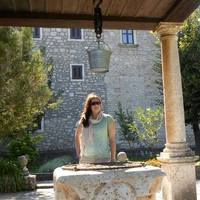Louise Rayne
Newcastle University, School of History, Classics and Archaeology, Department Member
Libya’s archaeological heritage is under serious threat, not only because of recent conflict, but also due to other factors such as urban expansion, agricultural development, natural resource prospection, vandalism, looting and natural... more
Libya’s archaeological heritage is under serious threat, not only because of recent conflict, but also due to other factors such as urban expansion, agricultural development, natural resource prospection, vandalism, looting and natural deterioration. The Endangered
Archaeology in the Middle East and North Africa Project (EAMENA) has developed a database and methodology using remote sensing and other techniques to rapidly document archaeological sites and any disturbances and threats to them in Libya and across the MENA
region. This paper will demonstrate this methodology and highlight the various types of disturbances and threats affecting the archaeology of Libya, concentrating on four case studies in different areas of the country, including the coastal plain around Zliten, a section of the Wadi Sofeggin in the pre-desert, and the desert oases of Jufra and Murzuq.
Archaeology in the Middle East and North Africa Project (EAMENA) has developed a database and methodology using remote sensing and other techniques to rapidly document archaeological sites and any disturbances and threats to them in Libya and across the MENA
region. This paper will demonstrate this methodology and highlight the various types of disturbances and threats affecting the archaeology of Libya, concentrating on four case studies in different areas of the country, including the coastal plain around Zliten, a section of the Wadi Sofeggin in the pre-desert, and the desert oases of Jufra and Murzuq.
This research presents the results of an interdisciplinary study which examined how increased adoption of water management technologies from the Hellenistic–Early Islamic period transformed the formerly marginal and rain-fed Balikh Valley... more
This research presents the results of an interdisciplinary study which examined how increased adoption of water management technologies from the Hellenistic–Early Islamic period transformed the formerly marginal and rain-fed Balikh Valley of Syria into a productive landscape. Data including CORONA satellite images, topographical models and archaeological surveys were used to identify and analyse systems of canals, qanats and tunnels. Analysis of this identified a peak in the use of irrigation in the later imperial
period, especially at the time of the Early Islamic empire when the city of Raqqa attained enhanced political significance, with indications that ancient systems were able to utilise most of the available water resources in the valley. Water management activity also appears to have led to changes in the environment of the Balikh, such as the formation and drainage of marshes and re-routing of existing hydraulic networks.
period, especially at the time of the Early Islamic empire when the city of Raqqa attained enhanced political significance, with indications that ancient systems were able to utilise most of the available water resources in the valley. Water management activity also appears to have led to changes in the environment of the Balikh, such as the formation and drainage of marshes and re-routing of existing hydraulic networks.
Research Interests:
Research Interests:
Human niche construction emphasizes the capacity of organisms to modify their environment and thereby influence their own and other species’ evolution. For the hydraulic landscapes of southern Mesopotamia we employ geoarchaeological data,... more
Human niche construction emphasizes the capacity of organisms to modify their environment and thereby influence their own and other species’ evolution. For the hydraulic landscapes of southern Mesopotamia we employ geoarchaeological data, remote sensing and ancient texts to suggest that major irrigation systems in the central Mesopotamian plains were a form of herringbone system and that they developed through human niche construction as a
result of the elaboration of crevasse splays along raised levees. The remarkable duration of these systems (some 4000 plus years) suggest that (a) they were sustainable over many millennia and (b) the short component canals could be managed by small lineages. However, equally they could be brought under the administration of the state.
result of the elaboration of crevasse splays along raised levees. The remarkable duration of these systems (some 4000 plus years) suggest that (a) they were sustainable over many millennia and (b) the short component canals could be managed by small lineages. However, equally they could be brought under the administration of the state.
